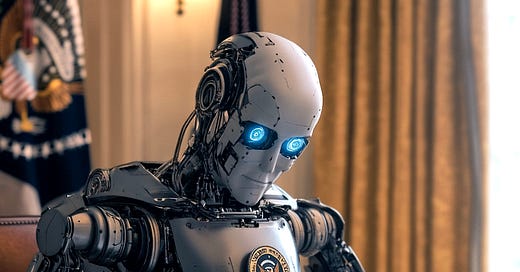In the age of digital signatures and automated communication, few devices encapsulate the convergence of tradition and technology like the autopen, a mechanical arm capable of replicating a person’s signature with remarkable precision. While widely used in bureaucratic and ceremonial functions, the autopen takes on unique significance when wielded by the President of the United States, where the stakes are constitutional, symbolic and sometimes controversial.
Invention and Early History
The autopen's origins date back to the early 1800s with rudimentary devices like the polygraph machine, famously used by Thomas Jefferson, which mechanically duplicated handwriting in real time using a series of connected pens.
Thomas Jefferson’s Portable Polygraph Machine
However, the modern autopen emerged during the mid-20th century, originally developed to relieve public figures, particularly in government and business, from the task of personally signing thousands of documents and letters.
The technology evolved to use custom signature templates mounted onto a mechanized arm. When activated, the autopen mimics the motion of a person’s hand, faithfully reproducing a pre-recorded signature in ink.
By the 1950s, the autopen was a staple in congressional and military offices. President Harry S. Truman is believed to be the first U.S. president to employ it. But its adoption was quiet, almost secretive, as many feared it would diminish the perceived authenticity of official documents.
Presidential Use
Presidents have long faced overwhelming demands on their time including the need to sign tens of thousands of letters, commemorations, proclamations, military appointments and routine bills. The autopen emerged as a pragmatic solution.
However, the use of the autopen by a president to sign legislation, not just ceremonial material, introduced significant constitutional questions.
President George W. Bush reportedly used the autopen to sign correspondence, but President Barack Obama pushed the device into constitutional debate. On May 27, 2011, while Obama was traveling in Europe, he used an autopen to sign an emergency extension of the Patriot Act. This marked the first known instance of a U.S. president using an autopen to sign a bill into law.
The use sparked outrage among some lawmakers and legal scholars. Rep. Tom Graves (R-GA) even requested a Justice Department opinion, arguing that Article I, Section 7 of the Constitution, stating that the President "shall sign" bills, implied a personal action, not one delegated to a machine.
Legal and Constitutional Debates
To address the controversy, the Office of Legal Counsel under President George W. Bush had already issued a confidential opinion in 2005, later cited during Obama’s use, stating that the autopen was legally permissible if the president directed its use and intended to sign the document.
Legal scholars remain divided:
Proponents argue that the key requirement is the president’s intent, not the physical act of writing. They compare it to a physically disabled president using an aide or tool to assist in signing.
Critics argue that the Constitution demands a deliberate, physical act, and that allowing machine signatures risks delegitimizing presidential accountability.
Continued Use and Secrecy
Despite controversy, the autopen continues to be employed in modern administrations. Presidents George W. Bush, Barack Obama and Joe Biden have all used it primarily for routine or ceremonial documents, but occasionally for urgent legislation when travel or emergencies intervene.
The White House, however, is typically opaque about when and how the autopen is used. This secrecy breeds speculation and suspicion, especially when transparency around presidential actions is considered vital.
Cultural and Symbolic Concerns
For some Americans, a presidential signature symbolizes the direct hand of the Commander-in-Chief. The autopen, by inserting a machine into this ritual, creates unease. Critics see it as a symbol of impersonal governance, a departure from accountability and tradition.
For others, it's simply a necessary tool, no different from the keyboard or telephone, one that allows presidents to fulfill their duties efficiently while maintaining continuity in government.
The autopen may be a relatively obscure piece of equipment, but it has raised profound questions about authenticity, presidential authority and the intersection of technology with constitutional norms. As the presidency continues to evolve in the digital age, the autopen remains a curious symbol of modern governance, part necessity, part controversy and wholly emblematic of a government striving to balance tradition with the demands of scale and speed.
Whether seen as a benign convenience or a breach of executive responsibility, the autopen has quietly etched its place in American history one signature at a time. Ponder, however, the circumstance where a president is incapacitated and others have secretly taken over the government, acting under color of the sitting president. How will the country know who really is in charge? Is the autopen a tool of convenience or a potential weapon to facilitate an invisible coup?
My column sees the world through the lens of Americana and focuses primarily on the culture and history of the United States. It uses the latest technological innovations combined with over seven decades of personal experience to create a vehicle that helps to communicate issues that have resonated throughout the history of the American experiment. My column is free to all but also offers a modest paid subscription for those who want to support the free flow of ideas.






